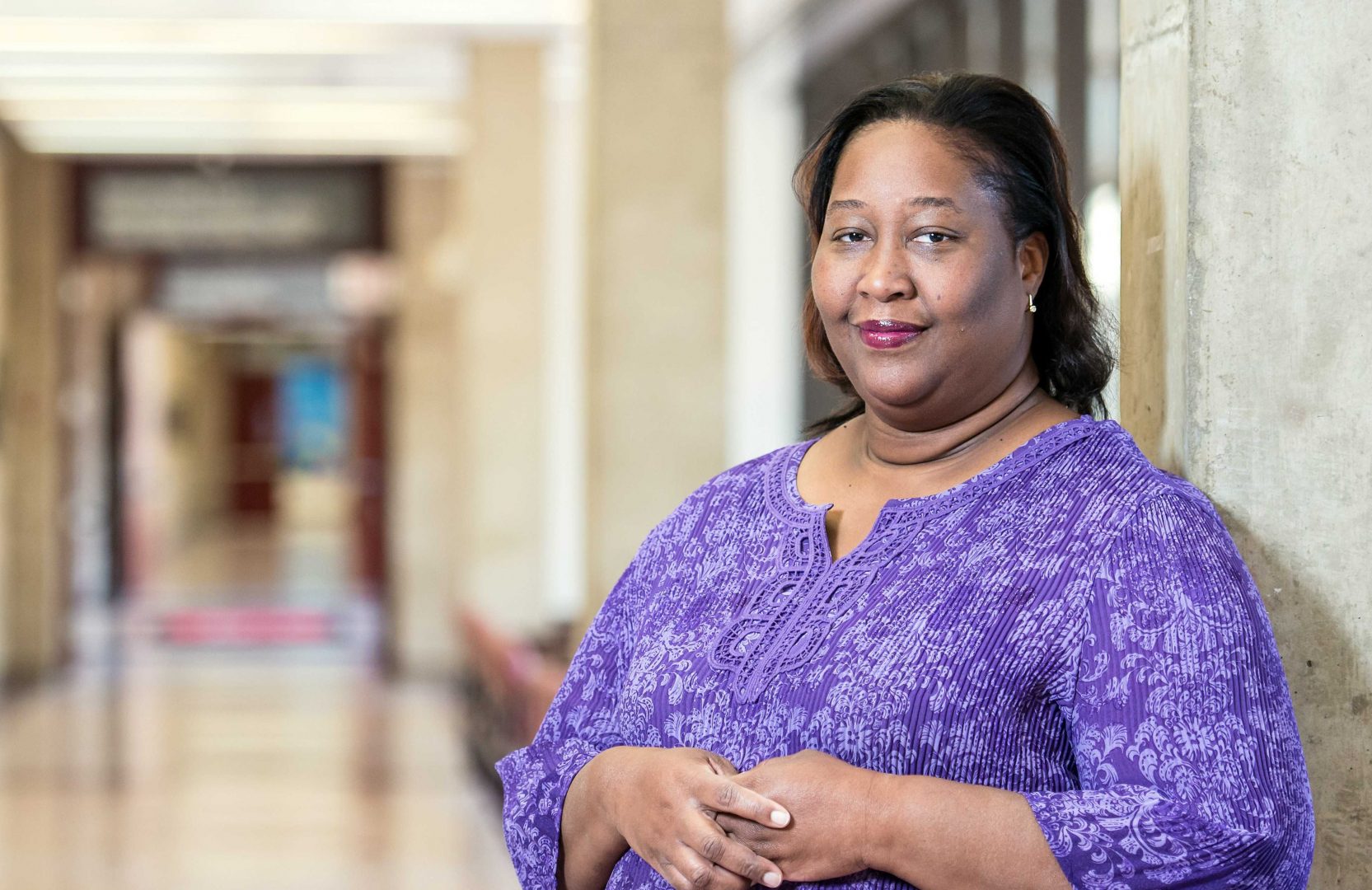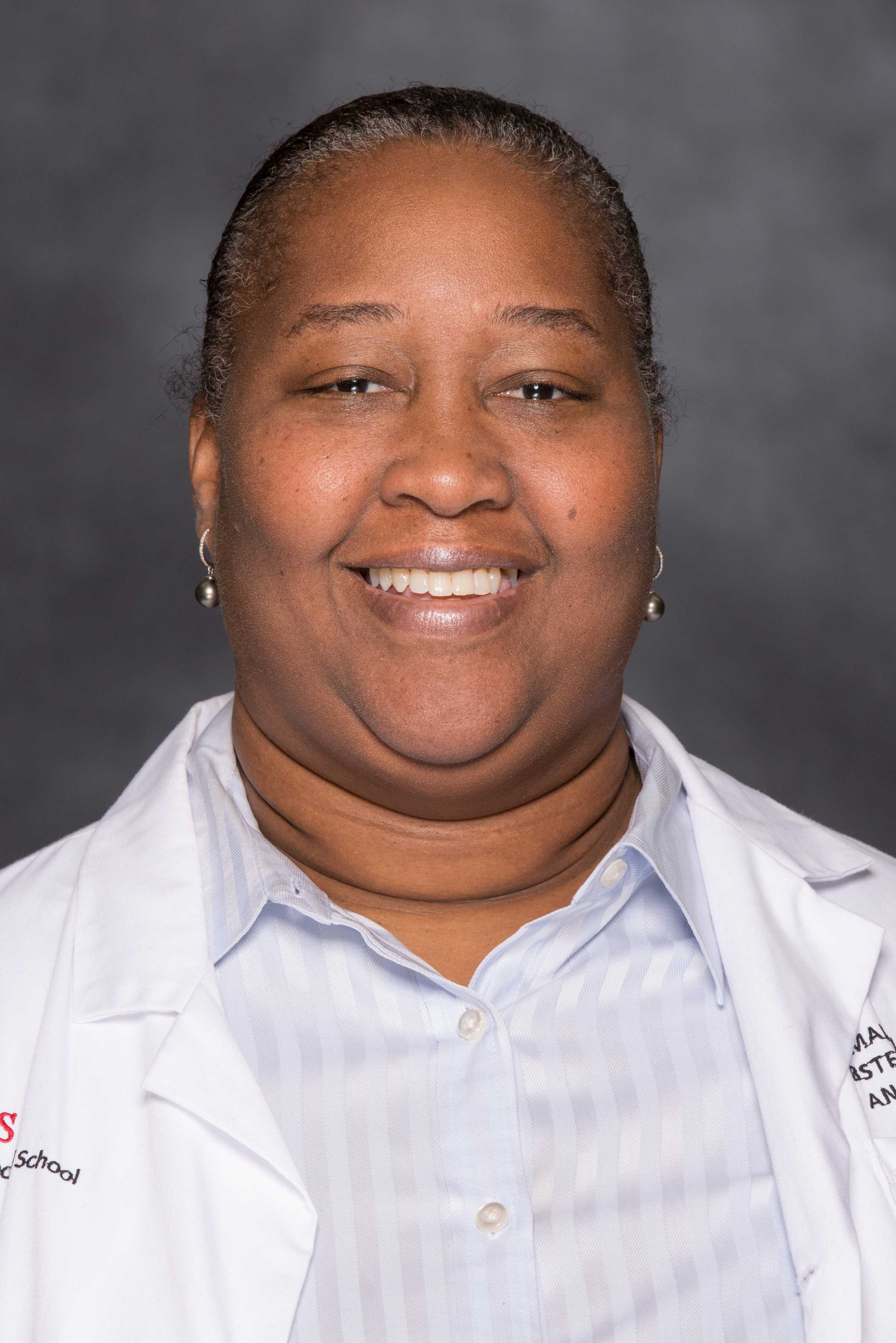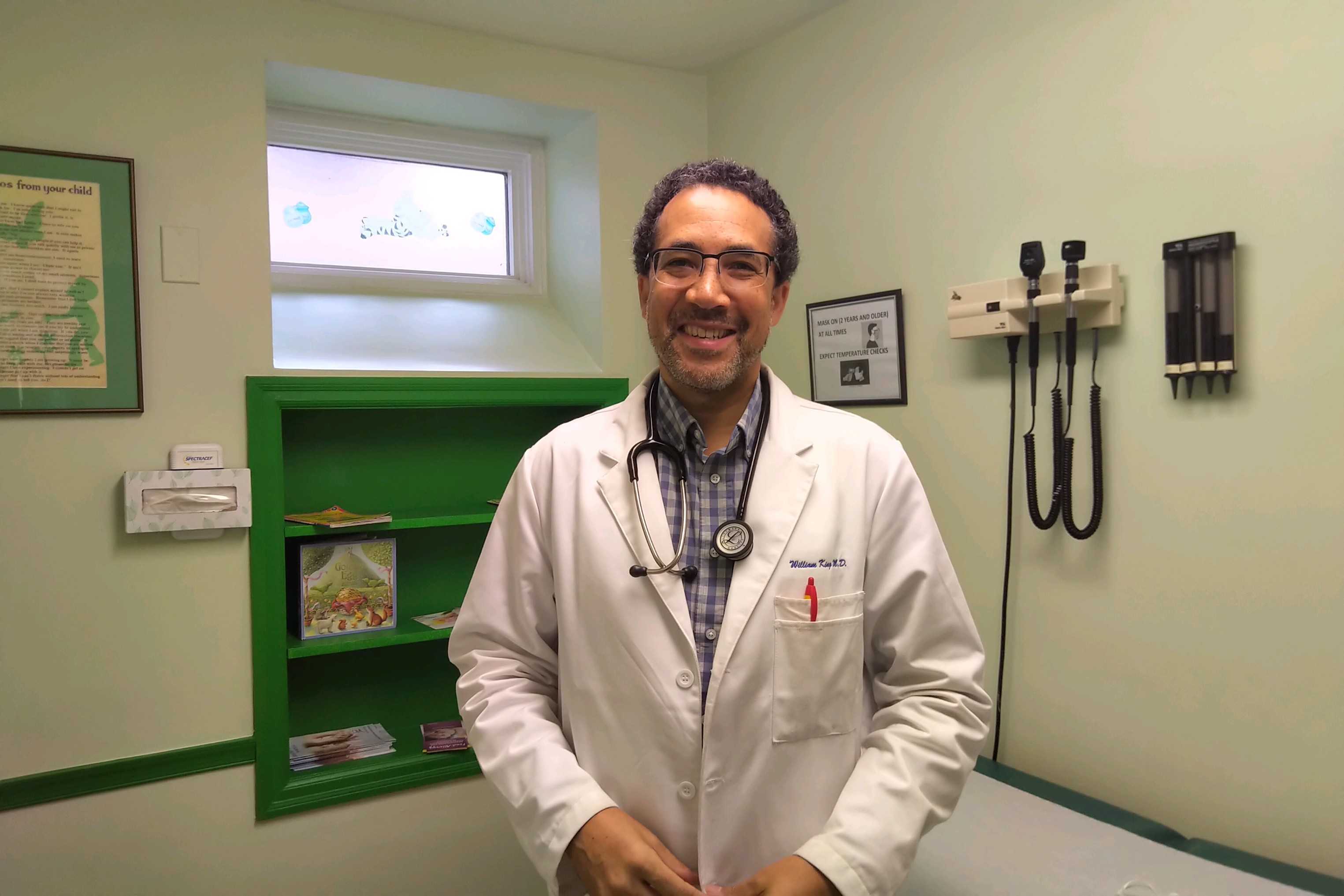
Dr. Natalie Roche is one of several physicians who had to temporarily stop practicing because she got COVID-19.

Dr. Natalie Roche is one of several physicians who had to temporarily stop practicing because she got COVID-19.

Dr. Natalie Roche is one of several physicians who had to temporarily stop practicing because she got COVID-19.
(Philadelphia) — As Dr. Pamela Huffman-DeVaughn watched some of her colleagues close the doors of their private practices, she feared she might have to do the same.
Like many small-business owners, the physician felt the effects of the coronavirus.
During the height of the pandemic, Huffman-DeVaughn had to decrease office hours at her three locations — in West Philadelphia, Germantown and Wilmington — and spaced out appointments, which reduced the number of patients walking through the doors.
“A medical practice is like any other business out here, restaurants, whatever. If you have less volume, you have less revenue. You can’t pay your staff, you can’t pay your expenses,” said Huffman-DeVaughn, who owns Pediatric and Adolescent Medicine Centers of Philadelphia, the largest Black-owned pediatric practice in the region.
She was forced to postpone the hiring of a new physician, already in progress prior to the pandemic. And she had to make some personal sacrifices to keep operating. Sometimes, Huffman-DeVaughn received less income than usual, other times she received none at all, and sometimes she reached into her savings to prevent furloughing or laying off doctors and other employees.
“They’ve been with me for a while, so I figured if anyone needs to take the sacrifice, I should take the sacrifice to keep them employed,” she said. “I just care about them, and I just felt I would sacrifice, rather than them sacrifice and not pay their rent, or not getting food for their kids, and that type of thing.”
The New Jersey Medical Association, an organization of Black physicians, found that 90% of its members reported hardships from COVID-19. Some practices had to furlough employees, some employees were too fearful to go to work, some practices lost revenue because they couldn’t perform surgeries and therefore had to decrease their office hours or close.

Dr. Pamela Huffman-DeVaughn has had to take pay cuts in order to keep her private practice operating during the COVID-19 pandemic. (Courtesy of Dr. Pamela Huffman-DeVaughn)
Though there has been some small-business assistance for physicians’ offices, a lot of time was lost because of pandemic restrictions.
“I think that when people think about small businesses, they don’t always think about medical practices, because we don’t equate medicine to business automatically. But at the end of the day, medicine, or having a medical practice, is a small business,” said Dr. Damali M. Campbell-Oparaji, president of the New Jersey Medical Association.
Doctors say it’s important that Black-owned practices have the resources to remain open.
“Scientific data has shown Black patients seen by Black doctors have better health outcomes. We are only one of the few Black practices left — so if we close our doors they have nowhere to go. I mean, they can go to other practices, but they feel better when they go to a practice that has African American doctors,” Huffman-DeVaughn said.
“They see people who look like them, they have aspirations — I have so many patients who want to be doctors now because they see us,” she said. “They feel comfortable with the health care they receive, they trust us more than if they go to some institution or other health care facility, they may tell us more about their health than they would another provider. And pre-COVID, that’s what we were trying to do — close this health care gap — and COVID came and put a bigger gap there.”
Witnessing the closure of Black-owned private practices has motivated her to fight to remain open, Huffman-DeVaughn said. Her Wilmington office was closed for several weeks because she was in the middle of relocating a half-mile away when the pandemic hit. She even considered closing the Wilmington office permanently, but her colleagues encouraged her to stay open.
“When one of the other doctors said she was closing her doors, I said, ‘Well, how many more do we have left?’ And she said, ‘We don’t have any more in private practice.’ So I had to take it upon myself to open the doors back and get those patients a home office to go to.”
In addition to income lost because fewer appointments and procedures were being scheduled, another setback for physicians at the start of the pandemic was the wait for telehealth to become a standard of care.
Telehealth existed prior to the pandemic, but physicians’ offices weren’t reimbursed at the same rates as they were for in-person visits. When coronavirus restrictions forced the wider transition to telehealth, it wasn’t clear whether physicians would be able to recoup their costs.
“They didn’t have the money to be able to introduce telehealth, and the margins are so narrow … financially, some of them couldn’t recover,” said Dr. Natalie E. Roche, an associate professor in the department of obstetrics, gynecology and reproductive health at Rutgers New Jersey Medical School.

Dr. Damali Campbell-Oparaji said 90% of members of the New Jersey Medical Association have reported financial losses due to COVID-19. (Courtesy of Rutgers New Jersey Medical School)
In addition, there’s often a delay in payment when working with insurance companies, said the New Jersey Medical Association’s Campbell-Oparaji, an assistant professor in the same department where Roche teaches.
“So if they are waiting to get paid and there’s a lag of two or three months in pay time — these small practices are like small businesses, so they don’t have a wide margin to work with. Waiting three months when this is the only revenue they’re going to get can be very detrimental to the practice,” she said.
“You can imagine a pediatric provider that has to pay for vaccines. They need money to come in in order to have the money to purchase supplies and vaccines,” Campbell-Oparaji said. “So if they’re not getting any money in, then they have very little revenue to buy that supply.”
Even prior to the pandemic, owners of private practices faced several challenges around upkeep, paying the bills and dealing with insurance companies, said Dr. Cedric Barnes, a member of the Delaware Medical Society who opened his private practice in Milford, Delaware, in 2002.
“This is a topic that continually comes up in their ability as far as insurance reimbursements and insurance contracts, trying to negotiate the appropriate fee schedule and means for your work in order to survive, in order to make ends meet, pay the bills, make sure the lights stay on,” he said. “You pay your employees, and you choose whether you get a salary or not, or your salary changes, [it’s] a day-to-day dilemma when you’re in private practice. Just keeping the lights on is a major priority.”
That’s why some physicians opt out of the Medicare system or take cash payments, with the patients getting their bills reimbursed by their insurance companies, Barnes said.
Converting his practice to the model known as MDVIP has helped him significantly, Barnes said. He still accepts insurance for regular visits, but patients also pay an annual fee to be members of the practice. That fee gives patients 24-hour access to Barnes, who is available by cellphone.
Overhead is, in part, why fewer Black physicians are getting into private practice, said Dr. William King, who works with Huffman-DeVaughn.
“A part of the reason why it’s hard to get young doctors in is because at a big health system they have pensions and dental and all these EMRs [electronic medical records] and software,” he said. “So a lot of the young physicians of color, the golden handcuffs at the academic centers hold them. I was at Temple, my Temple pension plan is bigger in six years than 14 years doing it on my own.”

Dr. William King says fewer Black physicians are getting into private practice. (Courtesy of Dr. William King)
Because Black-owned practices are often more likely to have patients with low incomes, the offices are sometimes harder-hit than practices owned by non-Black physicians, Huffman-DeVaughn said.
“Some of these patients have what we call social determinants of health, like poverty, so we see more of that than other practices, except hospital clinics, so we have fewer resources to work with, but those patients have a higher demand,” she said.
“And the insurance companies don’t necessarily give you much money to work with. I think the practices should even have a social worker or a nutritionist that the insurance companies should pay for to help the patients, but they don’t. So we have to work with what we have to try to get the patients proper help and services,” she said. “Hospitals get grant money and donations because they’re nonprofits, but when you have a private practice, you don’t get that kind of money to help you.”
COVID-19 has disproportionately affected communities of color — and Black physicians are not immune. A number of providers had to temporarily close their offices because they became ill, Campbell-Oparaji said, which limited access to care in the communities they served. And even when those offices reopened, some patients were too afraid to return, she said.
In March, Dr. Roche tested positive for COVID-19 and fought bilateral pneumonia. She had to stay home for a month while she recovered.
“As we see the disparities between Black illness and the death rate, I’m the perfect example. I’m over 60, I’m overweight and have medical problems that are chronic,” Roche said. “In the minority communities, it’s not like just the patients are getting sick — the health care providers are getting sick. And in an environment where we already have limited resources to care for these patients, it puts the patients at increased risk, because there are less people around available to care for them.”
Fewer Black physicians in a community may cause poor outcomes for people who find access to care challenging even in normal times.
“Black physicians tend to work in areas where Black patients and other minority patients are located. They’re also more likely to take public insurance, such as Medicaid,” Roche said. “So the most fundamental thing is you have to get your foot in the door to see the physician, and if they are not located in your neighborhood, and if they don’t take your insurance — and since Black patients have lower socioeconomic status, they are more likely to be dependent on public insurance — then you have to have someone who is even willing to take your insurance. So the disparities start right in the ability to get access to the doctor.”
A number of studies demonstrate that Black patients often have better outcomes if their physicians are Black.
For example, one study published in 2016 found there is racial bias when it comes to pain assessment and treatment recommendations for Black patients.
Another study published this year showed that Black babies are more likely to survive when cared for by Black physicians.
And a 2018 study found that Black male patients with Black physicians agreed to more preventative services than those seen by non-Black doctors, which seemed to be driven by better communication and more trust.
“If we see a shrinking of Black male physicians, there isn’t anyone those Black men can relate to,” Roche said. “How are things going to get better for them in terms of them managing their health in a system that can be very unwelcoming to Black patients? We are physicians of Black patients, and we understand in a very personal way how it has been unwelcoming to us.”
Barnes said his family can speak firsthand about how patients can relate more to physicians of the same culture. He said he couldn’t understand why every time he saw his grandfather, who suffered from heart failure, renal disease, lupus and high blood pressure, he appeared to be more weak than the last time.
“When I spoke with his physician, I clearly understood why there was no relationship or anything. It just so happened his cardiologist was from India. When I spoke to him, I could understand it very clearly, but my grandfather didn’t understand a word he was saying … and the doctor could not understand my grandfather when he asked questions” because of his Southern drawl from Georgia. His grandfather “basically just shut down. So he did whatever, he just sat there,” Barnes said. “The physician didn’t know this was happening.”
Once Barnes talked to his grandfather’s doctor, he said, “his condition improved because we were able to get him on the right medications. The doctor actually called me, so I was able to be that liaison between the two to get him better care. So those language barriers, those cultural barriers, present a problem.”
“I think physicians that are like you, not all of them, not 100%, but physicians that are like you, that come from that sort of culture, understand and know where you’re coming from, and are able to explain things in a way they understand,” Barnes added.
“Everything you say to any patient may not always come across, and they still do what they want to do, and that’s some of the frustrations of being a physician. But at least they start to understand and relate better to the physician and build that relationship and trust, so they’re able to ask questions about different medications, and make sure if they have any side effects they call you. So it’s building that honesty and relationship with each other, and that’s why I think people of color will relate better to people of color physicians.”
King, of Pediatric and Adolescent Medicine Centers of Philadelphia, said he and his colleagues have been seeing patients for important appointments, such as well visits and vaccinations, which has helped.
“Once they were confident we weren’t open for sick visits, they felt OK coming in,” he said.
At the beginning of the pandemic, Huffman-DeVaughn worried about having enough personal protective equipment to keep the doors open, and each time she ordered PPE, it became more costly. Though her practice is doing well now, she is concerned about PPE as the country goes through a resurgence of COVID-19.
“It would be nice if Congress gave us another round of PPE — that would be helpful,” Huffman-DeVaughn said.
She also hopes reimbursements for telehealth appointments will continue — it was a lifesaver for her patients, she said.
“I also think they should reimburse the doctors more money, because it has taken a toll on the practices overall,” Huffman-DeVaughn said. “And if they do that, I think we should get back to pre-COVID operations.”
WHYY is the leading public media station serving the Philadelphia region, including Delaware, South Jersey and Pennsylvania. This story originally appeared on WHYY.org.

Sometimes, your mornings are just too busy to catch the news beyond a headline or two. Don’t worry. The Morning Agenda has got your back. Each weekday morning, host Tim Lambert will keep you informed, amused, enlightened and up-to-date on what’s happening in central Pennsylvania and the rest of this great commonwealth.
The days of journalism’s one-way street of simply producing stories for the public have long been over. Now, it’s time to find better ways to interact with you and ensure we meet your high standards of what a credible media organization should be.